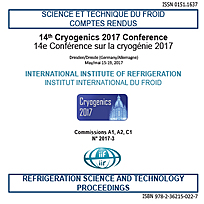
Document IIF
Défis du développement des aimants extérieurs supraconducteurs à large orifice à champ élevé dans le domaine de la recherche sur les aimants.
Challenges of high field large bore superconducting “outserts” for research magnets.
Résumé
The development of high temperature superconductors (HTS), with high critical fields at 4.2 Kelvin (K), has opened up a new experimental space: the investigation of the properties of matter within static magnetic fields > 22 Tesla (T). This has driven the requirement for large bore, high field “outsert” solenoid magnets, using more conventional NbTi and Nb3Sn conductors to provide the background field, within which an HTS coil can operate. We will discuss the challenges which have to be met to provide such compact, high field superconducting magnets, including quench energy management, coil interactions, mechanical support, eddy current forces and cryogen handling, and how they have been successfully overcome with the development of 19T, 150mm bore (Hochfeld-Magnetlabor Dresden, HLD) and 15T, 250mm bore systems (All superconducting 32 Tesla program at the National High Field Magnet Laboratory, Florida, NHMFL). We will also discuss where this emerging technology can be further developed for the next generation of experiments.
Documents disponibles
Format PDF
Pages : 6
Disponible
Prix public
20 €
Prix membre*
Gratuit
* meilleur tarif applicable selon le type d'adhésion (voir le détail des avantages des adhésions individuelles et collectives)
Détails
- Titre original : Challenges of high field large bore superconducting “outserts” for research magnets.
- Identifiant de la fiche : 30021722
- Langues : Anglais
- Source : Cryogenics 2017. Proceedings of the 14th IIR International Conference: Dresden, Germany, Mai 15-19, 2017.
- Date d'édition : 15/05/2017
- DOI : http://dx.doi.org/10.18462/iir.cryo.2017.0046
Liens
Voir d'autres communications du même compte rendu (71)
Voir le compte rendu de la conférence
Indexation
- Thèmes : Supraconduction
- Mots-clés : Supraconduction; Cryostat; Aimant; Transition resistive; Haute température; Experimentation; Champ magnétique
-
First transition effects in magnet-superconduct...
- Auteurs : PEREZ-DIAZ J. L., DIEZ-JIMENEZ E., SANDER B., et al.
- Date : 26/04/2010
- Langues : Anglais
- Source : Cryogenics 2010. Proceedings of the 11th IIR International Conference: Bratislava, Slovakia, April 26-29, 2010
- Formats : PDF
Voir la fiche
-
MINIMUM HEAT PULSE TO QUENCH A SUPERCONDUCTING ...
- Auteurs : SCOTT C. A.
- Date : 16/11/1981
- Langues : Anglais
- Source : Stability of superconductors.
- Formats : PDF
Voir la fiche
-
Cooling down and parameters during the first se...
- Auteurs : BESPALOV Y., NIKIFOROV D., PETROV M., FISCHER E., KHODZHIBAGIAN H.
- Date : 05/10/2021
- Langues : Anglais
- Source : Cryogenics 2021 online. Proceedings of the 16th IIR International Conference, October 5-7, 2021.
- Formats : PDF
Voir la fiche
-
Zur Kühlung supraleitender Hochfeld-Magnete in ...
- Auteurs : LEHMANN W.
- Date : 20/11/1996
- Langues : Allemand
- Source : DKV-Tagungsbericht 23. 1996 Leipzig.
Voir la fiche
-
AN ACOUSTIC EMISSION TECHNIQUE TO LOCALIZE MECH...
- Auteurs : TSUKAMOTO O., IWASA Y.
- Date : 16/11/1981
- Langues : Anglais
- Source : Stability of superconductors.
- Formats : PDF
Voir la fiche
